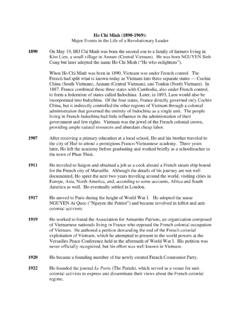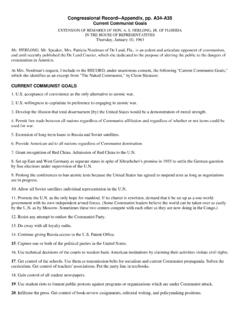Transcription of Understanding China's Political System
1 CRS Report for CongressPrepared for Members and Committees of Congress Understanding China s Political System Susan V. Lawrence Specialist in Asian Affairs Michael F. Martin Specialist in Asian Affairs March 20, 2013 Congressional Research Service 7-5700 R41007 Understanding China s Political System Congressional Research Service Summary This report is designed to provide Congress with a perspective on the contemporary Political System of China, the only communist party -led state in the G-20 grouping of major economies. China s communist party dominates state and society in China, is committed to maintaining a permanent monopoly on power, and is intolerant of those who question its right to rule. Nonetheless, analysts consider China s Political System to be neither monolithic nor rigidly hierarchical. Jockeying among leaders and institutions representing different sets of interests is common at every level of the System .
2 The report opens with a brief overview of China s leading Political institutions. They include the communist party and its military, the People s Liberation Army; the State, led by the State Council, to which the party delegates day-to-day administration of the country; and the National People s Congress (NPC), China s unicameral legislature. On paper, the NPC has broad powers. In practice, the legislature is controlled by the communist party and is able to exercise little of its constitutionally mandated oversight over the state and the judiciary. Following its 18th Congress in November 2012, the communist party ushered in a new party leadership. New State and NPC leaders took office following the opening session of the 12th NPC in March 2013. Following the overview, this report introduces a number of distinct features of China s formal Political culture and discusses some of their implications for relations.
3 Those features include the fact that China is led not by one leader, but by a committee of seven; that the military is not a national army, but rather an armed wing of the communist party ; that provincial leaders are powerful players in the System ; and that ideology continues to matter in China, with the communist party facing vocal criticism from its left flank each time it moves even further away from its Marxist roots. Other themes include the role of meritocracy as a form of legitimization for one- party rule, and ways in which meritocracy is being undermined; the introduction of an element of predictability into elite Chinese politics through the enforcement of term and age limits for holders of public office; the Chinese System s penchant for long-term planning; and the System s heavy emphasis on maintaining Political stability. The next section of the report discusses governance challenges in the Chinese Political System , from stove-piping and bureaucratic competition, to the distorting influence of bureaucratic rank, to factionalism, corruption, and weak rule of law.
4 The second half of the report is devoted to detailed discussion of China s formal Political structures the party , the military, the State, the National People s Congress, a consultative body known as the China People s Political Consultative Conference, and China s eight minor Political parties, all of which are loyal to the communist party . Also discussed are other Political actors who play a role in influencing policy debates, including the media, big business, research institutes, university academics, associations, and grassroots non-governmental organizations. The report concludes with a discussion of prospects for Political reform, noting that while China s new communist party chief has called for everyone to be bound by the constitution and law, party policy is to reject vigorously the notion of a multi- party System , separation of powers, a bicameral legislature, or a federal System , on the grounds that all are unsuited to China s conditions.
5 Understanding China s Political System Congressional Research Service Contents Introduction .. 1 Overview of China s Political Institutions .. 3 Features of China s Formal Political 4 Collective Leadership .. 5 The Military as an Armed Wing of the communist party .. 6 The Legislature: Strong on Paper, Weak in Practice .. 7 The Power of Provincial Governments .. 8 Document-Based Culture .. 10 The Importance of Ideology .. 11 The Ideal and Reality of Meritocracy .. 11 Age and Term Limits for Official Positions .. 12 Penchant for Long-Term Planning .. 12 Emphasis on Political Stability .. 13 Governance Challenges in the Chinese Political System .. 14 Stove-Piping and Bureaucratic Competition .. 14 The Distorting Influence of Bureaucratic Rank .. 15 Weak Rule of Law .. 17 Factionalism .. 17 18 China s Political Institutions in Detail .. 20 The Chinese communist party (CCP).
6 20 party Leadership Bodies .. 21 The party Bureaucracy .. 24 The People s Liberation Army (PLA) .. 25 The State .. 28 The National People s Congress (NPC) .. 31 The Chinese People s Political Consultative Conference (CPPCC) .. 32 The Minor Political Parties .. 33 Other Political 33 Traditional Media, New Media, and a Wired Citizenry .. 34 Big Business .. 35 Official and Quasi-Official Research Institutes .. 36 University Academics .. 37 Officially Sponsored Associations and Societies .. 38 Grassroots NGOs .. 38 Chinese Authorities View of Political Reform .. 39 Figures Figure 1. China s Leading Political Institutions .. 3 Figure 2. Map of China .. 9 Figure 3. The National-Level communist party Hierarchy .. 21 Figure 4. The People s Liberation Army .. 27 Understanding China s Political System Congressional Research Service Figure 5. The National People s Congress .. 32 Ta b l e s Table 1.
7 The 18th Central Committee s Politburo Standing Committee .. 5 Table 2. Select Chinese Institutions and Their Bureaucratic Ranks .. 16 Table 3. The18th Central Committee s Politburo ( Political Bureau) .. 22 Table 4. The 18th Central Committee s party Central Military Commission .. 25 Table 5. State Council Leaders .. 29 Table 6. Universities Ranked By Number of Alumni Among Current communist party Central Committee Members .. 37 Contacts Author Contact 41 Acknowledgments .. 41 Understanding China s Political System Congressional Research Service 1 Introduction This report is designed to provide Congress with a perspective on the contemporary Political System of China, the world s second-largest economic power, one of five permanent members of the United Nations Security Council, and the only communist party -led state in the G-20 grouping of major By introducing some of the distinct features and governance challenges of China s Political culture, the report aims to help Congress understand the ways in which Political actors in China interact, or in some cases, fail to interact, with implications for China s relationship with its neighbors and the world.
8 By introducing some of the leading Political institutions and Political actors in China, the report aims to help Congress understand where Chinese interlocutors sit within the Chinese Political System , gauge their relative influence, and judge the authoritativeness of their statements with respect to official policy. Where appropriate, the report also seeks to highlight ways in which China s Political culture affects official Chinese interactions with the government. The Chinese communist party (CCP or party ) has been in power in China for 63 years, a record of longevity that rivals and could in six years surpass that of the communist party of the Soviet The CCP assumed power in 1949 by means of a civil war victory over the forces of Chiang Kai-shek s Nationalists, who moved the seat of their Republic of China government to the island of Taiwan. The Communists named their new regime the People s Republic of China (PRC).
9 Although the CCP has been continually in power since, China s Political institutions and Political culture have evolved significantly over those decades, with the CCP s willingness to adapt helping to explain why it has, so far at least, avoided the fate of its sister parties in the Soviet Union and Eastern Europe. Today, although the party is committed to maintaining a permanent monopoly on power and is intolerant of those who question its right to rule, analysts consider the Political System to be neither monolithic nor rigidly hierarchical. Jockeying among leaders and institutions representing different sets of interests is common at every level of the System . Sometimes fierce competition exists among the members of the communist party s seven-man Politburo Standing Committee and 25-member Politburo, China s highest decision-making bodies. It also exists among ministries; between ministries and provincial governments, which are equals in bureaucratic rank; among provinces; and among the headquarters departments and service branches of the military.
10 The military and the Foreign Ministry are often on different pages. Deputies to the National People s Congress, China s weak legislature, sometimes attempt to push back against the government, the courts, and the public prosecutor s office. As part of a trend of very modest Political pluralization, moreover, other Political actors are increasingly able to influence policy debates. Such actors, who may join forces to advance particular causes, include an increasingly 1 The world s other remaining communist party -led states are Cuba, Laos, North Korea, and Vietnam, none of which is a member of the G-20. The G-20 countries are Argentina, Australia, Brazil, Canada, China, France, Germany, India, Indonesia, Italy, Japan, Mexico, Republic of Korea, Russia, Saudi Arabia, South Africa, Turkey, the United Kingdom, and the United States.












